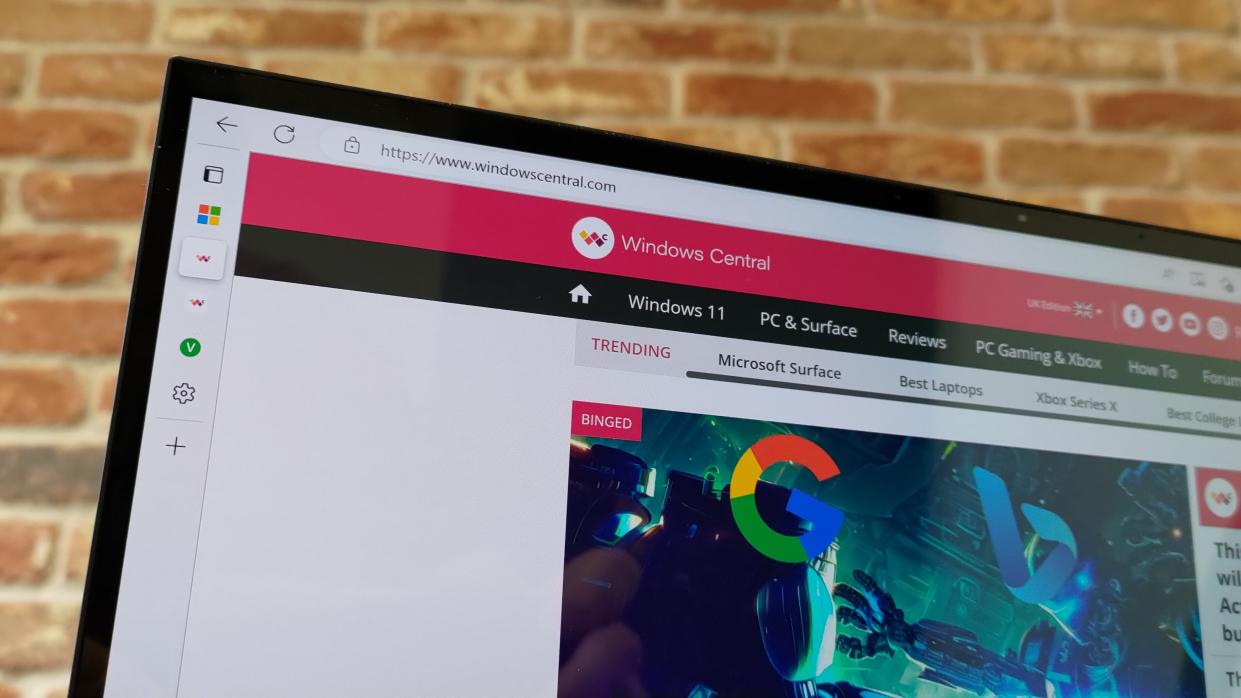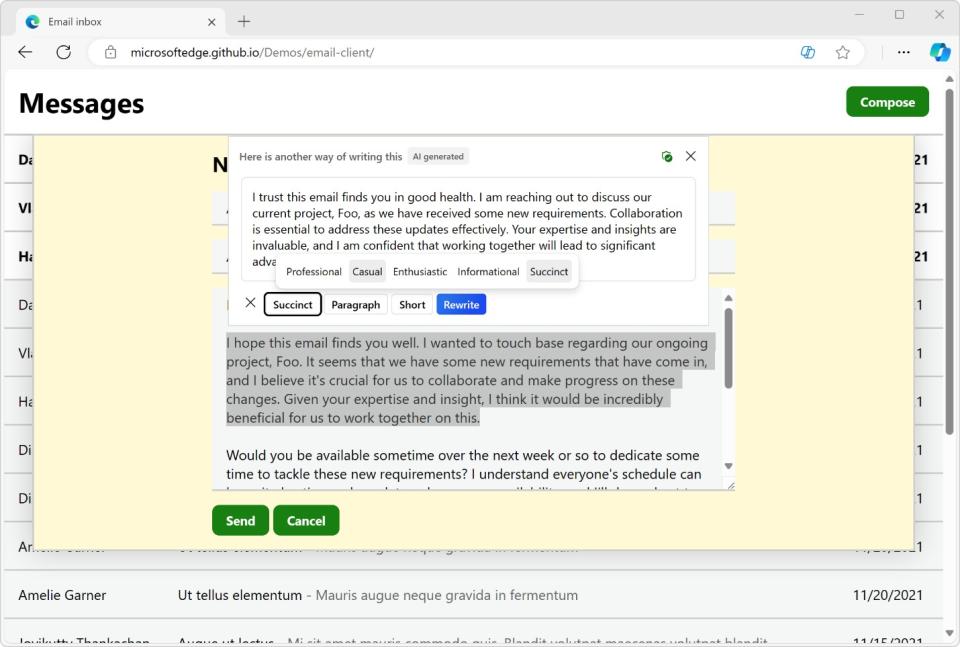Microsoft Edge's latest update has an AI feature I bet you missed

What you need to know
Microsoft outlined several additions to its Edge browser that have shipped recently in a blog post.
Highlights include rewriting text with AI, using a digital pen directly on web pages, and building text editors that support advanced text editing.
The company also discussed how it has improved clipboard access APIs and text prediction features.
When Microsoft Edge bumped up to version 124, the browser gained some handy new features. Among those new options is the ability to rewrite text with Copilot. Edge's Compose feature allows you to select text within an editable field and have Copilot rewrite that section using AI.
A blog post from Microsoft discusses the new Compose functionality as well as other features that have made their way to Edge recently. The company highlights:
Rewriting text with AI.
Writing with digital pens directly on web pages.
Building text editors that support advanced text-editing surfaces.
Improving clipboard access APIs.
And controlling text prediction features.

When rewriting text using Copilot, you can customize the tone, format, and length of what will be created. The new feature saves you a few clicks as well, since you know longer need to copy and paste text to rewrite it with Copilot.
Windows 11 already supported using a digital pen within input fields, but you can now use Windows Ink in more parts of the web. The option gives you another way to enter text into the Microsoft Edge's address bar and other elements.
The other features highlighted by Microsoft are aimed at developers and include the option to turn off text prediction and inline Compose within specific elements.
Here are all of the feature highlights that shipped with Edge version 124 last week:
Microsoft Edge version 124 feature updates
Email notifications for extension requests in the Microsoft Edge management service. The Microsoft Edge management service provides admins with the ability to receive email notifications for extensions that their users requested. This notification helps inform them promptly of any new feedback. Note: This experience is in public preview and can be accessed by opting in to targeted release in the Microsoft 365 admin center.
Enterprise secure AI controls in the Microsoft Edge management service. The Microsoft Edge management service now provides a new dedicated space for admins to manage all AI-related policies in the Edge browser. This helps enhance security and productivity for managed users and devices.
Customize organizational branding using the Microsoft Edge management service. Admins can customize their organization's branding assets onto Edge for Business through the Microsoft Edge management service. This branding can help users signed in with a Microsoft Entra ID more easily differentiate between multiple profiles and browser windows through visual cues on the profile pill, profile flyout, and Edge for Business taskbar icon.
This Microsoft Edge management service feature gives admins an enhanced experience to configure, preview, and customize how Edge for Business shows the following organization brand assets:
Organization name
Accent color
Organization logo
Edge for Business taskbar icon overlay
Note: This experience is in public preview and can be accessed by opting in to targeted release in the Microsoft 365 admin center. For more information, see Microsoft Edge for Business and Organization branding.
Automatic profile switching controls for Microsoft Edge for Business in the Microsoft Edge management service. The Microsoft Edge management service provides admins with the ability to configure settings for automatic profile switching in the Microsoft Edge browser. This can help enforce context separation between their end users' work and personal browsing.
Updated Edge Profile account re-authentication popup when Browser to Web Single-Sign-On (SSO) fails. Edge provides a browser to Web single sign-on (SSO) capability that lets a user sign in to their Edge Profile with a web account first and then automatically sign them into Microsoft first party websites.
This is done by saving cached credentials. This approach works until there's an authentication challenge to the cached credentials. A typical scenario is when a user changes their password on a different device. The cached credentials on the current device become outdated and SSO fails. Edge detects this failure and shows a re-authentication popup that prompts the user to update their cached credentials on the current device.
Removal of Web SQL - Web SQL support is completely removed. In prior releases, Web SQL support was disabled by default but could be re-enabled via the WebSQLAccess policy. After this change, there is no longer any mechanism to enable Web SQL support. This change is happening in the Chromium project, on which Microsoft Edge is based. For more information, see Intent to Deprecate and Remove Web SQL.
Cross-device Search Query History suggestions. The existing Search Query suggestions have been enhanced with cross-device query history in both Recent Searches and browser searches for enterprise users who have enabled Edge Sync across devices/browsers. From now on Edge will provide you with the relevant query history suggestions that you have previously searched before no matter where you did it. You can always trust Edge to help you quickly re-find the information that you accessed before.
Extending support for viewing MIP Protected PDF Files to different sovereignties (including GCCH). Sovereign cloud customers (including GCCH) will be able to open MIP protected PDF content in Microsoft Edge. This change will be available in the Microsoft Edge built-in PDF reader powered by Adobe Acrobat and the legacy Microsoft Edge PDF engine. Note: This feature is an experiment. Admins can use the feature flag "msMIPSovereigntyPdfViewSupport" to test this feature.
Copilot browser Context Policies. To summarize and answer questions based on browser context in Microsoft Edge, Copilot needs to be able to access the browser context. We're providing two new policies to offer more flexibility for admins to customize Edge browser context access across Copilot chats in Edge sidebar.
CopilotPageContext - Control Copilot access to browser context for Microsoft Entra ID profiles.
CopilotCDPPageContext - Control Copilot with Commercial Data Protection access to browser context for Microsoft Entra ID profiles.
The DiscoverPageContextEnabled policy is deprecated in Edge version 124 and will be obsoleted in Edge version 127.
Updated profile management and customization controls. Enhancing the profile management and customization experience through surfaced profile controls and an expanded range of default avatars. With these updates, users can effortlessly tailor their profiles to their preferences and select from a broader collection of profile avatars.
Microsoft Edge migrates the updates experience into Browser Essentials. Notifications on available Edge Updates will come from Browser Essentials instead of the Settings page for better visibility and experience.
Desktop Shortcut for New Enterprise Devices. New Microsoft Enterprise devices, including Windows Enterprise SKUs, Windows Server SKUs and any domain-joined or AAD-joined devices, running through Windows Out of Box Experience (OOBE) for the first time will see a Microsoft Edge desktop shortcut automatically created. This desktop shortcut provides users with an alternative way to access their Microsoft Edge browser without needing to manually pin and configure their set-up.
Updated profile options in new profile experience. Many users unintentionally create empty profiles, cluttering their workspace and impeding their browsing experience. To reduce clutter and the likelihood of profile churn, updated First Run Experience (FRE) string options encourage users to sign-in and meaningfully create profiles for an improved browsing experience, or easily cancel unintentional creation.
Updated default profile pill for EDU users in Edge for Business. To improve the applicability of the current Edge for Business default visuals, users signed in with an EDU account will see the default profile pill label updated to "School".
Updated UX for Microsoft Defender for Endpoint blocks. Microsoft Edge now provides a different blocking experience for Microsoft Defender for Endpoint based blocks (Web Content Filtering and Custom Indicators). For more information, see Web protection.

